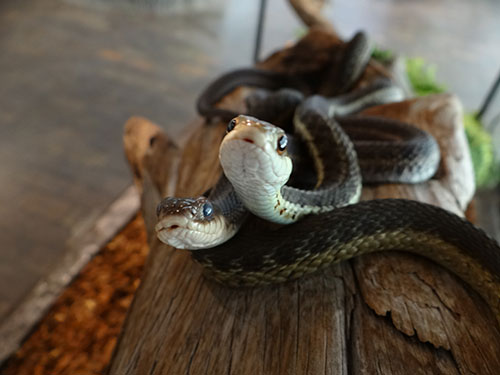Program Highlights
This exciting grade 6 program provides students with a unique opportunity to explore the classification of living things through “hands-on, minds-on” experiences with live animals and real animal specimens. Created specifically to meet curriculum outcomes in the grade 6 science unit on the diversity of life, this program uses an object-based and skills-based approach to encourage students to develop their classification and observation skills.
Touch the jaw of a shark! Observe the wet skin of a bull frog! Through multisensory observation, discussion, asking questions, and recording their observations, students will explore Nova Scotian animals representing different animal groups: mammals, birds, reptiles, amphibians, fish, and invertebrates. In a concluding activity, students will be challenged as a group to construct classification charts to compare the characteristics of these animals.
Curriculum Outcome Links
Specific Curriculum Outcomes
- Create and analyze their own chart or diagram for classifying and describe the role of a common classification system (300-15)
- Classify animals as vertebrates or invertebrates and compare the characteristics of mammals, birds, reptiles, amphibians, and fishes (300-16, 300-17)
Science Skills
- Classify according to several attributes and create a chart or diagram that shows the method of classifying (206-1)
- Communicate questions, ideas, and intentions, and listen to others while conducting investigations (207-1)
Program Length
90 min
Program Capacity
- 2 classes (60 students maximum)
- 1 chaperone for every 5 students
Cost
The charge for this program is $3.55 per student which includes the tax. The teachers are admitted free of charge. One chaperone is admitted free for every five students (1:5 ratio).
Activities
10 minutes: Introduction
The program begins with an introduction to classification and the scientific language of classification through an interactive activity.
60 minutes: Gallery Stations
In small groups, students will visit seven animal exhibits around the Museum representing different animal groups: mammals, birds, reptiles, amphibians, fish, and invertebrates (arthropods and echinoderms). At each exhibit, students will observe the animals and related specimens through multiple senses. Students will record their observations through writing and/or drawing in field notebooks.
20 minutes: Conclusion
In a concluding activity, students will be challenged as a group to use their observations to classify the animals they have observed into groups. A t-chart will be used for the students to create a dichotomous classification chart to compare and classify the animals based on several different characteristics.
Information and Reservations
This program is fully booked for the fall. To book a visit in April, May and early June 2024, please email mnhgroups@novascotia.ca
